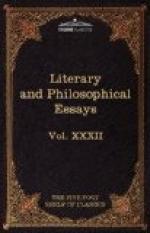In comparing the Breton cycle as the French trouveres knew it, and the same cycle as it is to be found in the text of the Mabinogion, one might be tempted to believe that the European imagination, enthralled by these brilliant fables, added to them some poetical themes unknown to the Welsh. Two of the most celebrated heroes of the continental Breton romances, Lancelot and Tristan, do not figure in the Mabinogion; on the other hand, the characteristics of the Holy Grail are presented in a totally different way from that which we find in the French and German poets. A more attentive study shows that these elements, apparently added by the French poets, are in reality of Cymric origin. And first of all, M. de la Villemarque has demonstrated to perfection that the name of Lancelot is only a translation of that of the Welsh hero Mael, who in point of fact exhibits the fullest analogy with the Lancelot of the French romances. [Footnote: Ancelot is the diminutive of Ancel, and means servant, page, or esquire. To this day in the Cymric dialects Mael has the same signification. The surname of Poursigant, which we find borne by some Welshmen in the French service in the early part of the fourteenth century, is also no doubt a translation of Mael.] The context, the proper names, all the details of the romance of Lancelot also present the most pronounced Breton aspect. As much must be said of the romance of Tristan. It is even to be hoped that this curious legend will be discovered complete in some Welsh manuscript. Dr. Owen states that he has seen one of which he was unable to obtain a copy. As to the Holy Grail, it must be avowed that the mystic cup, the object after which the French Parceval and the German Parsifal go in search, has not nearly the same importance among the Welsh. In the romance of Peredur it only figures in an episodical fashion, and without a well-defined religious intention.
“Then Peredur and his uncle discoursed together, and he beheld two youths enter the hall, and proceed up to the chamber, bearing a spear of mighty size, with three streams of blood flowing from the point to the ground. And when all the company saw this, they began wailing and lamenting. But for all that, the man did not break off his discourse with Peredur. And as he did not tell Peredur the meaning of what he saw, he forbore to ask him concerning it. And when the clamour had a little subsided, behold two maidens entered, with a large salver between them, in which was a man’s head, surrounded by a profusion of blood. And thereupon the company of the court made so great an outcry, that it was irksome to be in the same hall with them. But at length they were silent.” This strange and wondrous circumstance remains an enigma to the end of the narrative. Then a mysterious young man appears to Peredur, apprises him that the lance from which the blood was dropping is that with which his uncle was wounded, that the vessel contains the blood and the head of one of his cousins, slain by the witches of Kerloiou, and that it is predestined that he, Peredur, should be their avenger. In point of fact, Peredur goes and convokes the Round Table; Arthur and his knights come and put the witches of Kerloiou to death.




